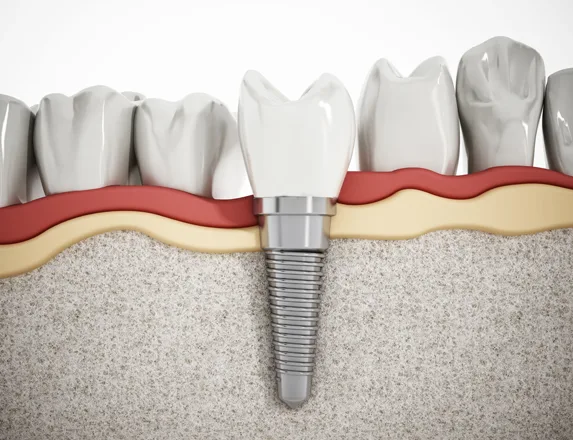Dental implants have revolutionized the world of dentistry by offering a long-lasting solution to tooth loss. As you explore your options for tooth replacement, it’s important to understand the different types of dental implants available and how they can benefit your smile.
The two most common types of dental implants are endosteal and subperiosteal implants. Endosteal implants, the more popular option, are embedded directly into your jawbone and can support one or more artificial teeth. On the other hand, subperiosteal implants are placed on top of the jawbone but beneath the gum tissue, which makes them ideal for people with less jawbone density.
Some specialized cases may require other dental implant options, such as single tooth implants for individuals missing only one tooth or implant-supported bridges that offer support and stability to a set of missing teeth. As you consult with your dentist, they’ll help you determine the best implant solution tailored to your specific needs.
Understanding Dental Implants
Dental implants are a popular and effective solution for replacing missing teeth. They provide a strong foundation for fixed or removable replacement teeth that match your natural teeth. In this section, we will discuss the types of dental implants and what you can expect from the procedure.
There are mainly two types of dental implants: endosteal and subperiosteal. Endosteal implants are the most common type, in which the implant is embedded directly into the jawbone. Subperiosteal implants, on the other hand, are placed under the gum but on top of the jawbone, making them suitable for patients who don’t have enough healthy jawbone for an endosteal implant.
Here is a brief overview of the two types of implants:
-
Endosteal implants: These implants are placed directly into the jawbone. The procedure generally involves drilling a small hole into the jawbone to insert a titanium screw, which acts as the tooth root. After the surrounding bone heals and grows around the implant, a dental crown, bridge, or denture can be attached to the abutment, which is connected to the implant.
-
Subperiosteal implants: For patients who lack sufficient healthy jawbone, subperiosteal implants are a good option. With this type, a metal framework is custom-made to fit onto the jawbone. Upon healing, gums cover the framework while the post protrudes through the gum line. Artificial teeth are then attached to the post.
Apart from these two primary types, there are other specialized dental implant options you might come across. These include:
- Mini implants: These are smaller than traditional implants and are often used to secure dentures in place. They can sometimes be inserted less invasively and heal faster than full-sized implants.
- All-on-4: This is a technique where a full set of teeth can be supported with just four implants. It can be a cost-effective option for those who need to replace an entire upper or lower arch of teeth.
The procedure for dental implants varies depending on the type and individual circumstances. In general, dental implant surgery involves several stages that may take a few months to complete. This is because it allows time for the bone to heal and for the implant to firmly fuse with the surrounding bone.
In summary, dental implants are an effective and versatile tooth replacement option that mimics the look and feel of natural teeth. There are several types to choose from, including endosteal, subperiosteal, mini, and All-on-4. Your dentist will recommend the most suitable option for you based on your specific needs and oral health.
Types of Dental Implants
When considering dental implants, it’s essential to know the different types available to make the best choice for your situation. While there are several types of dental implants, they can be mainly categorized into two broad categories: endosteal and subperiosteal. Additionally, there are specific implant options designed for single or multiple tooth replacements.
Endosteal implants are the most common and widely used type of dental implant. These implants are placed directly into your jawbone and are typically made of titanium. Endosteal implants resemble small screws in shape and provide a strong and stable foundation for the dental prosthesis, such as a crown or bridge. By integrating with the surrounding bone during a process called osseointegration, these implants offer a high success rate and long-lasting results.
Subperiosteal implants are less common and are placed on top of the jawbone under the gum tissue. This type of implant is suitable for patients with a shallow or insufficient jawbone, making endosteal implants unfeasible. Subperiosteal implants consist of a metal framework that sits on the jawbone, with posts protruding through the gums to support the dental prosthesis. However, they may be less stable and have a lower success rate compared to endosteal implants.
Depending on your needs, the dental implants can be further classified based on the number of teeth they replace:
-
Single tooth implant: This option is ideal if you have one missing tooth you want to replace for aesthetics, comfort, and function. It involves placing an implant into the jawbone, followed by attaching a dental crown to the implant screw.
-
Implant-supported bridge: If you have multiple missing teeth in a row, an implant-supported bridge may be the best option. This type of implant involves placing two or more implants to support a dental bridge, replacing the missing teeth with artificial teeth known as pontics.
Remember to consult your dentist to discuss your specific needs and determine the most suitable implant type for your situation. Receiving the appropriate dental implants can significantly improve your appearance, comfort, and overall oral health.
Dental Implant Procedure
Process of Getting Dental Implants
Getting dental implants involves a series of steps to ensure you receive a successful tooth replacement. It’s essential to understand the dental implant procedure as it helps you prepare for surgery and manage realistic expectations.
1. Consultation: The first step is meeting with your dentist, who will discuss your needs, examine your oral health, and design an individualized treatment plan. They’ll also review the costs and benefits, ensuring you make an informed decision.
2. Dental Implant Placement: The implant consists of a metal, screw-like post, which will replace the tooth root. Your dentist or oral surgeon will perform the surgery by making a small incision in your gum and placing the implant into your jawbone.
3. Osseointegration: After placing the implant, osseointegration occurs – where the jawbone fuses with the implant. This process is crucial for the implant’s stability and usually takes a few months to complete. Patience is essential during this phase, as rushing the process could compromise your implant’s success.
4. Abutment Placement: Once osseointegration is complete, your dentist will place an abutment (a connector) that sits above the gumline. The abutment connects the implant with the future artificial tooth or crown.
5. Crown placement: The final step in the dental implant procedure involves attaching your custom-made crown to the abutment. Your dentist will ensure the color, shape, and size of the crown match your natural teeth, giving you a comfortable and aesthetically pleasing result.
While the dental implant procedure may seem lengthy, the benefits include a natural-looking tooth replacement that functions like a real tooth, improved oral support, and long-lasting results. By understanding the process, you’ll be better prepared to undergo this transformative procedure.
Conclusion
In summary, there are various types of dental implants available to cater to different needs and conditions. The main types of dental implants are:
- Endosteal: The most common type, embedded in the jawbone and can hold one or more artificial teeth.
- Subperiosteal: Placed on the jawbone rather than in it, suitable for those with inadequate bone height or who cannot undergo bone augmentation.
- Implant-Supported Bridge: Ideal for people with several missing teeth, the implant acts as an anchor for the bridge.
- Mini Implants: Smaller in diameter, they can be used in areas with limited space or bone density.
It’s important to discuss your options with your dentist when considering dental implants. They can assess your situation, provide recommendations, and guide you through the process. Keep in mind that dental implants can vary in cost, procedure, and recovery time.
Remember, having dental implants can greatly improve your quality of life by restoring your smile, confidence, and the ability to eat and speak with ease. Taking the time to research, consult, and weigh the pros and cons of each type of implant will ultimately help you make the best decision for your oral health and well-being.


